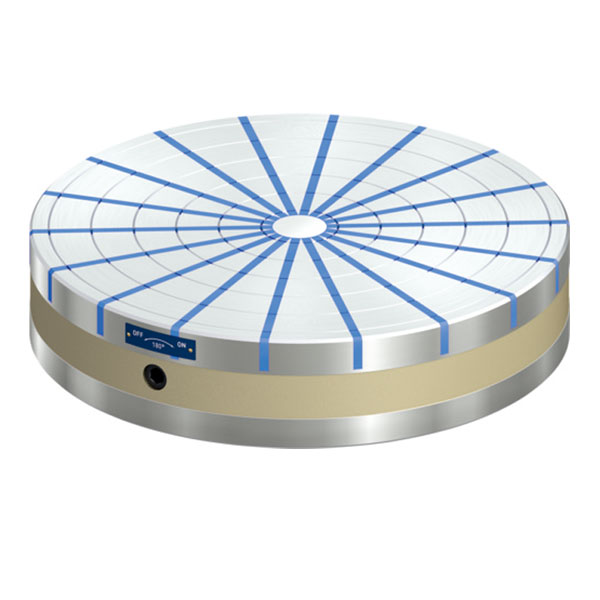Automatic loading and unloading process
As is well known, fixtures are compared to the "hands" of machine tools. Fixtures are not only used for metal cutting, but also for inspection, assembly, welding of parts, and production line manufacturing. The fixture industry is not a pillar industry, but mechanical processing inevitably requires the use of various types and types of fixtures, and fixtures are indispensable process equipment. Just like the "barrel principle" in management, the scale, technology, and application level of the fixture industry sector will affect the overall level of mechanical manufacturing systems.
The electrically activated permanent magnet clamping technology is considered a major trick in shortening installation time and reducing workpiece clamping deformation. Through some specific designs, even large components can be clamped within seconds without causing deformation, while ensuring that they can be machined from all five faces. Even in the field of standard modules, research and development work has not stagnated: modern electromagnetic suction cups can achieve visualization or automated monitoring of the clamping process
The secret of using magnetic clamping technology to achieve deformation free workpiece clamping lies in the fact that the floating magnetic block has an extended part and the optimized interference profile. The floating magnetic guide block on the electrically activated magnetic pole plate is flexibly docked with the workpiece, which can compensate for the uneven problem of the workpiece during the first clamping process, without causing deformation of the workpiece, and can process five faces in a single operation.
During secondary clamping, it is possible to achieve a workpiece smoothness that is difficult for mechanical clamping devices to achieve; In practical operation, it is often possible to achieve flatness with an accuracy of 0.02mm. Unlike traditional clamping methods using claws or embedded claws, it avoids specific damage or deformation to the workpiece. On the contrary, users can benefit from high clamping accuracy and large workpiece finish. This advantage can be better utilized when dealing with large areas of steel plates or other easily deformed workpieces. Clamping with a larger surface area can reduce vibration and protect the machine tool spindle and cutting edge. The operation is also very simple: place the ferromagnetic workpiece on top and activate the electromagnetic suction cup using a short-term current pulse. Within a few seconds, permanent magnets can achieve long-term and secure clamping of the workpiece without further energy consumption.

The potential application range of magnetic clamping technology is very broad, and the efficiency potential is enormous. These two points have been reflected in several practical application examples implemented by Schunk:
For the accurate processing of large steel materials such as welding frames, gantry frames, or fixed parts, if traditional clamping methods are used, a large amount of work will be required, such as first welding the steel strip to repair the workpiece. Subsequently, it is necessary to expend energy to reinstall, rewind, and heat treat the workpiece several times after processing. Especially for large workpieces, it usually even requires two operators to complete the clamping process. Magnetic clamping technology can significantly shorten the time consumption of this process.
The vertically installed SCHUNK MAGNOS square magnetic pole plate achieves flexible and deformation free suspension clamping of steel up to 10000mm in length. The flexible use of magnetic blocks can ensure rapid adaptation to various workpiece diameters. To achieve this effect, a row of magnetic poles can be simply manipulated to complete the release or support action. The floating magnetic guide block installed in a mobile manner can be adjusted independently to adapt to the corresponding workpiece contour, achieving relatively soft and low deformation clamping work. And it completely avoids the common point like damage and distortion deformation that occur when processing long steel profiles. Even narrow and long workpieces can be easily clamped by one operator. Due to the characteristic of vertical clamping preparation, the operability of the workpiece has also been optimized. At the same time, the machine tool workbench can also be used for other processing operations without removing the electromagnetic suction cup.
In terms of track component production, SCHUNK MAGNOS dedicated solutions have brought various advantages in practice: compared to traditional clamping solutions, the processing frequency and processing time have been reduced by more than 50%. In addition, due to the horizontal placement of the workpiece avoiding deformation due to heat and ensuring a stable position without vibration during the machining process, the reliability of the machining process is greatly improved.
On the T-shaped magnetic poles, clamp the sheet metal with a length of up to 6000mm from both the bottom and side simultaneously. At the same time, it can also clamp additional workpieces on the top horizontal plane, which brings a certain degree of creativity to the use of magnetic clamping schemes. The magnetic clamping device adopts two magnetic configurations: one is the horizontal 50 magnetic pole spacing used for vertical clamping of the bottom surface of the workpiece; Another method is to use a 70 pole spacing in the depth direction for horizontal clamping of the workpiece head. The actual clamping process is completed through two magnetization cycles: first, the workpiece is pre clamped to establish complete surface contact with the magnet throughout its entire length. Then use full power magnetization to achieve high magnetic saturation and achieve high clamping force.




